
original at www.af.mil |
F-16C banks right with a load of cluster bombs
(U.S. Air Force photo)
In an air-to-surface role, the F-16 can fly more than 500 miles (860 kilometers), deliver its weapons with superior accuracy, defend itself against enemy aircraft, and return to its starting point. An all-weather capability allows it to accurately deliver ordnance during non-visual bombing conditions. In designing the F-16, advanced aerospace science and proven reliable systems from other aircraft such as the F-15 and F-111 were selected. These were combined to simplify the airplane and reduce its size, purchase price, maintenance costs and weight. The light weight of the fuselage is achieved without reducing its strength. With a full load of internal fuel, the F-16 can withstand up to nine G's -- nine times the force of gravity -- which exceeds the capability of other current fighter aircraft. The cockpit and its bubble canopy give the pilot unobstructed forward and upward vision, and greatly improved vision over the side and to the rear. The seat-back angle was expanded from the usual 13 degrees to 30 degrees, increasing pilot comfort and gravity force tolerance. The pilot has excellent flight control of the F-16 through its "fly-by-wire" system. Electrical wires relay commands, replacing the usual cables and linkage controls. For easy and accurate control of the aircraft during high G-force combat maneuvers, a side stick controller is used instead of the conventional center-mounted stick. Hand pressure on the side stick controller sends electrical signals to actuators of flight control surfaces such as ailerons and rudder. |
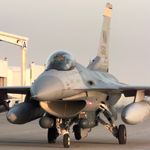
original at www.af.mil |
Operation Southern Watch - New Mexico Guard F-16s on Patrol
(U.S. Air Force photo by Airman 1st Class Greg Davis)
A New Mexico Air National Guard F-16C Fighting Falcon taxis out for an Operation Southern Watch patrol mission. The "#34 of the 188th Fighter Squadron, 150th Fighter Wing, New Mexico Air National Guard, fly Block 40 F-16's and are based at Kirtland Air National Guard Base. The 188th Fighter Squadon recently joined their active duty counterparts from the 523rd Fighter Squadron, 27th Fighter Wing, to support air operations over the No-Fly, No-Drive Zone in Southern Iraq. |
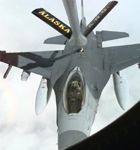
original at www.af.mil |
Cope Thunder refueling
(U.S. Air Force photo by Staff Sgt. Bill Morris)
An F-16 from the 178th Fighter Wing, 162nd Fighter Squadron based at Springfield-Beckley MAP, Ohio, takes on fuel, June 10, from a KC-135R tanker from the 168th Air Refueling Wing, Eielson Air Force Base, Alaska, during Cope Thunder. About 500 Air Force and Navy people deployed to Elmendorf AFB, Alaska, for the exercise, which provided realistic combat training for aircrews and ground support forces. |

original at www.af.mil |
F-16CJ "Wild Weasel" from the 13th Fighter Squadron
(U.S. Air Force photo by Master Sgt. Dave Nolan)
Master Sgt. Haskel Johnson of the 35th Operations Support Squadron at Misawa Air Base, Japan, makes final checks on an F-16CJ "Wild Weasel" before a training mission. The 35th FW is one of three fighter wings that performs the "Wild Weasel" mission. The aircraft's primary weapon is the high-speed anti-radiation missile, or HARM, which destroys enemy surface-to-air missile sites and their accompanying radars. |

original at www.af.mil |
555th Fighter Squadron F-16C
(U.S. Air Force photo by Senior Amn. Jeffrey Allen)
An F-16C Fighting Falcon from the 555th Fighter Squadron, Aviano Air Base, Italy, moves into position to take on fuel behind a KC-135 Stratotanker flown by the 186th Air Refueling Wing, Meridian, Miss., on Feb. 26, 1999. The 186th is deployed to Aviano AB, Italy supporting Kosovo-related operations. (990226-F-2171A-007) |
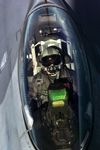
original at www.af.mil |
Closeup of F-16C Pilot in flight
(U.S. Air Force photo by Senior Amn. Jeffrey Allen)
An F-16 Fighting Falcon from the 555th Fighter Squadron, Aviano Air Base, Italy, moves into position to take on fuel behind a KC-135 Stratotanker flown by the 186th Air Refueling Wing, Meridian, Miss., on Feb. 26, 1999. The 186th is deployed to Aviano Air Base supporting Kosovo-related operations. (990226-F-2171A-004) |

original at www.af.mil |
F-16D with AGM-65 Mavericks and LANTIRN
(Photo courtesy Lockheed Martin)
An F-16D with LANTIRN and a load of AGM-65 Mavericks from Edwards AFB, CA, flys a test mission over southern Calif. The AGM-65 Maverick is a tactical, air-to-surface guided missile designed for close air support, interdiction and defense suppression mission. It provides stand-off capability and high probability of strike against a wide range of tactical targets, including armor, air defenses, ships, transportation equipment and fuel storage facilities. Low Altitude Navigation and Targeting Infrared for Night, or LANTIRN, is a system for use on the Air Force's premier fighter aircraft -- the F-15E Eagle and F-16C/D Fighting Falcon. LANTIRN significantly increases the combat effectiveness of these aircraft, allowing them to fly at low altitudes, at night and under-the-weather to attack ground targets with a variety of precision-guided and unguided weapons. |
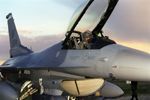
original at www.af.mil |
F-16 pilots, maintainers continue Kosovo operations
(U.S. Air Force Photo by Technical Sgt. James D. Green)
AVIANO AIR BASE, Italy (AFPN) -- A fighter pilot from the 510th Fighter Squadron here makes final preparations before flying a mission in support of Operation Allied Force. NATO aircraft are currently bombing targets in the former Republic of Yugoslavia, in the hopes of bringing Yugoslav Serbs back to the negotiating table. |
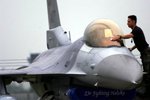
original at www.af.mil |
Keeping the glass clean
(U.S. Air Force Photo by Senior Airman Jeffrey Allen)
AVIANO AIR BASE, Italy (AFPN) -- Airman First Class Leandro Ramirez from the 23rd Fighter Squadron, Spangdahlem Air Base, Germany, cleans the canopy of an F-16CJ at Aviano Air Base, Italy. The F-16 is one of several U.S. aircraft flying missions out of the air base in support of Operation Allied Force. Members of the 23rd FS are deployed to Aviano AB supporting the NATO air campaign. |
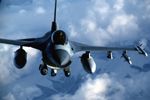
original at www.af.mil |
F-16C flys a combat mission during Allied Force
(U.S. Air Force Photo by Senior Airman Greg Davis)
The F-16 Fighting Falcon is a compact, multirole fighter aircraft. It is highly maneuverable and has proven itself in air-to-air combat and air-to-surface attack. It provides a relatively low-cost, high-performance weapon system for the United States and allied nations. In an air combat role, the F-16's maneuverability and combat radius (distance it can fly to enter air combat, stay, fight and return) exceed that of all potential threat fighter aircraft. It can locate targets in all weather conditions and detect low flying aircraft in radar ground clutter. In an air-to-surface role, the F-16 can fly more than 500 miles (860 kilometers), deliver its weapons with superior accuracy, defend itself against enemy aircraft, and return to its starting point. An all-weather capability allows it to accurately deliver ordnance during non-visual bombing conditions. In designing the F-16, advanced aerospace science and proven reliable systems from other aircraft such as the F-15 and F-111 were selected. These were combined to simplify the airplane and reduce its size, purchase price, maintenance costs and weight. The light weight of the fuselage is achieved without reducing its strength. With a full load of internal fuel, the F-16 can withstand up to nine G's -- nine times the force of gravity -- which exceeds the capability of other current fighter aircraft. |

original at www.af.mil |
F-16 fires an AGM-88 HARM missile
(Photo by Tom Reynolds)
An F-16 Fighting Falcon from the 416th Flight Test Squadron Edwards Air Force Base, Calif., fires an AGM-88 HARM missile during testing. The F-16 is a multi-role fighter that first took to the Edwards skies 25 years ago. Since then, about 4,000 Falcons have been produced, with the F-16 Combined Test Force here busy keeping the compact fighter up to date. |
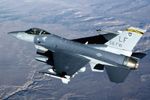
original at www.af.mil |
56th Fighter Wing F-16C flys a training mission
(U.S. Air Force Photo by Master Sgt. Dave Nolan)
The F-16 Fighting Falcon is a compact, multirole fighter aircraft. It is highly maneuverable and has proven itself in air-to-air combat and air-to-surface attack. It provides a relatively low-cost, high-performance weapon system for the United States and allied nations. In an air combat role, the F-16's maneuverability and combat radius (distance it can fly to enter air combat, stay, fight and return) exceed that of all potential threat fighter aircraft. It can locate targets in all weather conditions and detect low flying aircraft in radar ground clutter. In an air-to-surface role, the F-16 can fly more than 500 miles (860 kilometers), deliver its weapons with superior accuracy, defend itself against enemy aircraft, and return to its starting point. An all-weather capability allows it to accurately deliver ordnance during non-visual bombing conditions. |

original at www.af.mil |
56th Fighter Wing F-16C over Monument Valley, Arizona
(U.S. Air Force Photo by Master Sgt. Dave Nolan)
The F-16C Fighting Falcon is a compact, multirole fighter aircraft. It is highly maneuverable and has proven itself in air-to-air combat and air-to-surface attack. It provides a relatively low-cost, high-performance weapon system for the United States and allied nations. In an air combat role, the F-16's maneuverability and combat radius (distance it can fly to enter air combat, stay, fight and return) exceed that of all potential threat fighter aircraft. It can locate targets in all weather conditions and detect low flying aircraft in radar ground clutter. In an air-to-surface role, the F-16 can fly more than 500 miles (860 kilometers), deliver its weapons with superior accuracy, defend itself against enemy aircraft, and return to its starting point. An all-weather capability allows it to accurately deliver ordnance during non-visual bombing conditions. |

original at www.af.mil |
Wolfpack F-16s take part in Commando Sling
(U.S. Air Force Photo by Master Sgt. Val Gempis)
Paya Lebar Air Base, Singapore (AFPN) -- A maintenance technician from the 8th Fighter Wing, Kunsan Air Base, Korea, stands by his F-16 aircraft while a Singaporean C-130 aircraft taxies past. The aircraft were preparing to fly an Exercise Commando Sling mission. The objectives of the exercise are to fulfill a U.S. commitment for continuous presence in Singapore, to test the long-range mobilization ability of deploying U.S. forces, and to maximize dissimilar air combat training between U.S. Air Force F-16s and Singapore air force F-16 and F-5 aircraft. |
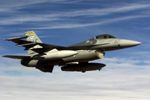
original at www.af.mil |
F-16 Falcon from the 56th Fighter Wing
(U.S. Air Force Photo by Staff Sgt. Julia L Barklow)
U.S. Air Force Lt. Michael "Yugo" Ferrario pilots a F-16 "Fighting Falcon" of the 61st Fighter Squadron, 56th Fighter Wing, Luke Air Force Base, Ariz., during a Surface Attack Tactics (SAT) Large Force Employment (LFE) mission.The F-16 Fighting Falcon is a compact, multirole fighter aircraft. It is highly maneuverable and has proven itself in air-to-air combat and air-to-surface attack. It provides a relatively low-cost, high-performance weapon system for the United States. Ferrario is originally from Sterling, Mich. |

original at www.af.mil |
Thunderbirds over the Grand Canyon
(U.S. Air Force Photo by Staff Sgt. Kevin Gruenwald)
The U.S. Air Force Air Demonstration Squadron, the Thunderbirds, performs precision aerial maneuvers demonstrating the capabilities of Air Force high performance aircraft to people throughout the world. The squadron exhibits the professional qualities the Air Force develops in the people who fly, maintain and support these aircraft. The Thunderbirds squadron is an Air Combat Command unit composed of eight pilots (including six demonstration pilots), four support officers, three civilians and more than 130 enlisted personnel performing in 25 career fields. A Thunderbirds air demonstration is a mix of formation flying and solo routines. The four-aircraft diamond formation demonstrates the training and precision of Air Force pilots, while the solo aircraft highlight the maximum capabilities of the F-16. |
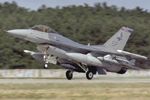
original at www.af.mil |
Spangdahlem's 23rd Fighter Squadron lands in Slovakia
(U.S. Air Force Photo by Senior Airman Esperanza Berrios)
An F-16 from Spangdahlem Air Base, Germany, is the first U.S. warplane to touch Slovak soil after touching down at Malacky Air Base, Slovakia, on Apr. 1, 2000. Col. Richard Reynolds, Spangdahlem's 23rd Fighter Squadron commander, landed the plane. More than 200 Spangdahlem airmen are deployed to Malacky for a two-week training exercise that is giving U.S. and Slovak air forces an opportunity to share tactics, techniques and procedures. (U.S. Air Force photo by Senior Airman Esperanza Berrios) |

original at www.af.mil |
AGM-154A Joint Stand-off Weapon on F-16CJ
(U.S. Air Force Photo by Tech. Sgt. Cary Humphries)
An F-16CJ fighter aircraft at Shaw Air Force Base, South Carolina, is uploaded with a full compliment of weapons including the new AGM-154A Joint Stand-off Weapon (JSOW). The 20th Fighter Wing at Shaw Air Force Base is the first Air Force F-16 unit to implement the JSOW system. |
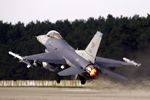
original at www.af.mil |
Spangdahlem F-16s launch from Malacky Airfield, Slovakia
(U.S. Air Force Photo by Master Sgt. Keith Reed)
After being assured that the airfield is cleared for take-off, Major John Taylor of the 23rd Fighter Squadron, Spangdahlem Air Base, Germany takes flight from Malacky Airfield, Slovakia. The 23rd Fighter Squadron, and 10 of their F-16's are deployed to Malacky, Slovakia as part of a 200 person team taking part in a bi-lateral agreement between Slovakia and the United States for support from the Slovak air force at Malacky and use of the nearby Kuchyna bombing range, which will allow U.S. pilots in Europe to expand their training while strengthening ties of friendship between the two nations. |
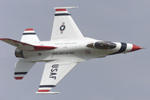
original at www.af.mil |
Thunderbirds in Europe
(U.S. Air Force Photo by Staff Sgt. Mitch Fuqua)
An F-16C Fighting Falcon with the Air Force's Thunderbirds does a fly-by for the crowd during the LaComina Airshow on June 11, 2000, in Pordenone, Italy. The U.S. Air Force Air Demonstration Squadron, the Thunderbirds, performs precision aerial maneuvers demonstrating the capabilities of Air Force high performance aircraft to people throughout the world. The squadron exhibits the professional qualities the Air Force develops in the people who fly, maintain and support these aircraft. The Thunderbirds squadron is an Air Combat Command unit composed of eight pilots (including six demonstration pilots), four support officers, three civilians and more than 130 enlisted personnel performing in 25 career fields. A Thunderbirds air demonstration is a mix of formation flying and solo routines. The four-aircraft diamond formation demonstrates the training and precision of Air Force pilots, while the solo aircraft highlight the maximum capabilities of the F-16. The pilots perform approximately 30 maneuvers in a demonstration. |
^^ TOP ^^
|

